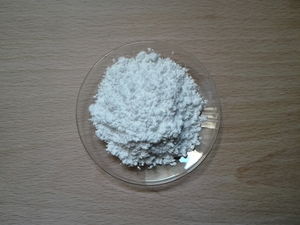Barium carbonate
 Sample of barium carbonate
| |
| Names | |
|---|---|
| IUPAC name
Barium carbonate
| |
| Other names
Witherite
| |
| Properties | |
| BaCO3 | |
| Molar mass | 197.34 g/mol |
| Appearance | White solid |
| Odor | Odorless |
| Density | 4.286 g/cm3 |
| Melting point | 811 °C (1,492 °F; 1,084 K) (polymorphic transformation) |
| Boiling point | 1,450 °C (2,640 °F; 1,720 K) (decomposes) |
| 0.0016 g/100 ml (8.8 °C) 0.0022 g/100 ml (18 °C) 0.0024 g/100 ml (20 °C) 0.0024 g/100 ml (24.2 °C) | |
| Solubility | Reacts with acids Insoluble in organic solvents |
| Vapor pressure | ~0 mmHg |
| Thermochemistry | |
| Std molar
entropy (S |
112 kJ/mol |
| Std enthalpy of
formation (ΔfH |
-1,219 kJ/mol |
| Hazards | |
| Safety data sheet | Sigma-Aldrich |
| Flash point | Non-flammable |
| Lethal dose or concentration (LD, LC): | |
| LD50 (Median dose)
|
418 mg/kg (rat, oral) |
| Related compounds | |
| Related compounds
|
Magnesium carbonate Calcium carbonate Strontium carbonate |
| Except where otherwise noted, data are given for materials in their standard state (at 25 °C [77 °F], 100 kPa). | |
| Infobox references | |
Barium carbonate is an insoluble barium salt of carbonic acid with the formula BaCO3, even less soluble than barium sulfate. Unlike BaSO4, barium carbonate reacts with acids and can serve as precursor to any barium salt.
Contents
Properties
Chemical
Heat causes it to decompose, liberating carbon dioxide and turning into the oxide BaO.
- BaCO3 → BaO + CO2
It reacts with all acids, resulting in barium salts and carbon dioxide. This makes it a useful precursor to all barium compounds.
- BaCO3 + HX → BaX2 + H2O + CO2
Physical
Barium carbonate is a white chalk-like powder, insoluble in water and virtually all solvents, though it dissolves in acids, releasing carbon dioxide.
When heated to 811 °C, it undergoes polymorphic transformation and starting from 1,360-1,450 °C it decomposes to release carbon dioxide. Barium carbonate is quite dense, 4.286 g/cm3
Availability
Barium carbonate is sold by chemical suppliers. Some rat poisons may contain barium carbonate.
Occasionally, pottery stores may sell barium carbonate.
It also occurs naturally as the mineral witherite.
Preparation
Barium carbonate is prepared from barium sulfate by lengthy boiling under reflux with sodium carbonate. This reaction is sometimes called the Curie reaction, because Marie Curie prepared radium carbonate the same way.
- BaSO4 + Na2CO3 → BaCO3 + Na2SO4
The reaction is very slow and takes a long time to completion.
Projects
- Anything having to do with barium
- Make barium peroxide
Handling
Safety
Barium carbonate is safe to handle, unless ingested. Upon ingestion, it is acutely poisonous, as it reacts with gastric acid to form barium chloride which is soluble in water. In the event of accidental ingestion, immediately consume a soluble sulfate solution, like aqueous magnesium sulfate.
Storage
It can be stored anywhere and in anything. But places that may have acidic vapors are best avoided.
Disposal
To neutralize barium carbonate, use sulfuric acid. The resulting inert barium sulfate can be dumped anywhere.